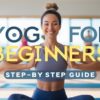Nursing is a demanding profession that requires long hours on your feet, constant movement, and emotional resilience. Whether you’re tending to patients in a busy hospital or working in a long-term care facility, the physical and mental stresses of nursing can take a toll on your body and spirit. Integrating yoga into your daily routine can be a game-changer—helping to reduce muscle tension, boost energy levels, and promote mental clarity. This comprehensive guide is designed specifically for nurses, offering a range of stretches and mindful practices that can be done even during a hectic 12-hour shift.

Introduction: The Demands of a Nurse’s Life
Nurses are the backbone of the healthcare system. With responsibilities that span from providing critical patient care to managing high-stress situations, the physical and mental strains can be overwhelming. Long shifts, often 12 hours or more, demand constant physical effort—standing for prolonged periods, bending over patients, lifting heavy loads, and dealing with the unpredictability of emergencies. These stresses not only lead to muscle fatigue and joint pain but also contribute to high levels of stress and burnout.
Incorporating yoga into your daily life offers a holistic approach to self-care. Yoga combines physical postures (asanas), breathing exercises (pranayama), and meditation to create a balanced practice that nurtures both body and mind. For nurses, yoga can be a vital tool to alleviate physical discomfort, boost energy, and manage the stress inherent in such a demanding profession.
The Importance of Self-Care for Nurses
Physical Toll of Nursing
The physical demands of nursing can lead to:
- Muscle Strain: Long hours of standing and repetitive movements can cause muscle fatigue, particularly in the back, neck, and legs.
- Joint Pain: Lifting, bending, and twisting can contribute to joint discomfort and, over time, lead to chronic issues.
- Poor Posture: The fast-paced environment often forces nurses to adopt awkward postures, which can result in misalignment and pain.
Mental and Emotional Stress
Beyond the physical challenges, the emotional burden of caring for patients, managing emergencies, and working in high-pressure environments can lead to:
- Increased Stress Levels: Constant exposure to stressful situations can elevate cortisol levels, leading to anxiety and burnout.
- Fatigue: Mental exhaustion from making critical decisions and dealing with emotional situations can compound physical fatigue.
- Emotional Burnout: The emotional intensity of patient care can wear down even the most resilient individuals, impacting overall well-being.
The Role of Yoga in Self-Care
Yoga offers a unique solution that addresses both physical and emotional challenges. Its benefits for nurses include:
- Reducing Muscle Tension: Gentle stretches help release tight muscles and improve flexibility.
- Enhancing Posture: Yoga strengthens the core and back, promoting better alignment and reducing the risk of injury.
- Stress Reduction: Mindful breathing and meditation lower stress levels, promote relaxation, and improve mental clarity.
- Boosting Energy: Regular yoga practice can revitalize the body, helping you feel more energized during long shifts.
- Emotional Resilience: Yoga cultivates mindfulness and self-compassion, which are key to managing the emotional aspects of nursing.
The Science Behind Yoga for Stress and Pain Relief
Numerous studies have highlighted the positive impact of yoga on both physical and mental health. For nurses, the benefits are particularly significant:
Cortisol Reduction and Stress Management
Yoga has been shown to lower cortisol levels—the body’s primary stress hormone. By incorporating deep breathing and relaxation techniques, yoga helps regulate the stress response, which is crucial for nurses who are frequently in high-pressure situations.
Improved Blood Circulation
Gentle stretching and movement enhance blood circulation, delivering oxygen and nutrients to tired muscles. This increased circulation not only reduces muscle fatigue but also promotes faster recovery after long shifts.
Enhanced Core Strength and Posture
Many yoga poses focus on strengthening the core muscles, which are essential for maintaining proper posture. A strong core supports the spine and reduces the risk of back injuries, a common complaint among nurses.
Mind-Body Connection
Yoga emphasizes mindfulness, helping you tune into your body’s signals. This heightened awareness can guide you in recognizing early signs of fatigue or tension, allowing you to take preventive measures before discomfort escalates.
Essential Yoga Stretches for Nurses
Below is a collection of yoga poses and stretches specifically chosen to address the common physical challenges nurses face during long shifts. These exercises can be done in short breaks, in a quiet corner of the hospital, or at home after a long day.
1. Seated Neck and Shoulder Stretch

Purpose: Relieves tension in the neck and shoulders, a frequent area of stiffness for nurses.
How to Do It:
- Sit comfortably in a chair with your feet flat on the floor.
- Slowly tilt your head to the right, bringing your ear toward your shoulder. Hold for 10 seconds.
- Return to center and repeat on the left side.
- Next, lift your shoulders toward your ears as you inhale, then release them down as you exhale.
- Perform 5–10 repetitions.
Benefits:
- Reduces tension in the neck and shoulder muscles.
- Improves blood flow to the upper back.
- Eases stiffness caused by prolonged sitting or standing.
2. Seated Cat-Cow Stretch

Purpose: Increases spinal flexibility and relieves back tension, particularly beneficial after long hours of bending or standing.
How to Do It:
- Sit on the edge of a chair with your hands resting on your knees.
- Inhale as you arch your back and lift your chest (Cow Pose).
- Exhale as you round your spine and tuck your chin (Cat Pose).
- Continue this gentle flow for 1–2 minutes, synchronizing your breath with your movements.
Benefits:
- Enhances mobility of the spine.
- Relieves lower back tension and pain.
- Promotes a relaxed, fluid motion that can help alleviate stiffness.
3. Standing Forward Fold (Uttanasana) – Modified for Nurses

Purpose: Stretches the back, hamstrings, and shoulders, while also calming the mind.
How to Do It:
- Stand with your feet hip-width apart.
- Inhale deeply, then exhale as you hinge at your hips, folding forward.
- Let your arms hang down, or clasp opposite elbows for a deeper stretch.
- If standing isn’t an option, perform this stretch seated on a chair.
- Hold for 30 seconds to 1 minute, breathing slowly and deeply.
Benefits:
- Releases tension in the back and legs.
- Reduces mental stress by promoting a state of surrender.
- Helps counteract the effects of prolonged sitting or standing.
4. Chest Opener Stretch

Purpose: Opens the chest and shoulders, areas that often become tight from wearing scrubs and being in a fast-paced environment.
How to Do It:
- Stand or sit with your back straight.
- Clasp your hands behind your back and straighten your arms.
- Gently lift your hands away from your back, opening your chest.
- Hold the stretch for 20–30 seconds while taking slow, deep breaths.
Benefits:
- Improves posture by opening up the chest.
- Reduces shoulder and upper back tension.
- Enhances breathing by allowing for a fuller expansion of the lungs.
5. Seated Spinal Twist

Purpose: Increases mobility in the spine and massages the abdominal organs, aiding digestion and relieving tension.
How to Do It:
- Sit on a chair with your feet flat on the floor.
- Place your right hand on the back of the chair and your left hand on your right thigh.
- Gently twist your torso to the right, turning your head to follow the twist.
- Hold for 20–30 seconds, then return to center and switch sides.
Benefits:
- Enhances spinal mobility.
- Stimulates digestion and relieves abdominal tension.
- Helps improve overall posture and reduces lower back pain.
6. Seated Leg Extensions

Purpose: Stretches the hamstrings and calves, which can become tight after long periods of standing or sitting.
How to Do It:
- Sit on a chair with your back straight.
- Extend one leg out in front of you, keeping the heel on the floor.
- Flex your foot to stretch the calf, and gently lean forward from your hips to deepen the stretch in the hamstring.
- Hold for 20–30 seconds, then switch legs.
Benefits:
- Improves flexibility in the hamstrings and calves.
- Reduces the risk of cramps and stiffness in the legs.
- Enhances overall lower-body mobility.
7. Savasana (Corpse Pose) – Quick Restorative

Purpose: Provides a moment of complete relaxation to integrate the benefits of your stretching routine and recharge your body and mind.
How to Do It:
- Lie down on your back on a comfortable surface (or sit quietly if lying down isn’t possible during a break).
- Allow your arms and legs to relax completely.
- Close your eyes and focus on deep, slow breathing.
- Stay in this restful pose for 2–3 minutes, letting go of any remaining tension.
Benefits:
- Promotes deep relaxation and stress relief.
- Helps lower cortisol levels and reduce overall fatigue.
- Allows the body to recover and reset, even in short bursts.
A Sample Yoga Routine for Nurses (20–30 Minutes)
Here’s a comprehensive routine designed to be performed during breaks or at the end of a long shift. This sequence combines the essential stretches mentioned above with mindful breathing techniques to rejuvenate your body and mind.
Warm-Up (5 Minutes)
- Seated Breath Awareness (2 Minutes):
- Sit comfortably in a chair with your feet flat on the floor.
- Close your eyes and take deep, mindful breaths, focusing on the sensation of air entering and leaving your body.
- Use this time to mentally prepare for your practice, setting a positive intention for self-care.
- Neck and Shoulder Rolls (3 Minutes):
- Slowly roll your neck clockwise and then counterclockwise, completing 5–10 circles in each direction.
- Perform shoulder shrugs by lifting your shoulders to your ears and then releasing them down slowly.
- Follow with gentle arm circles to further release tension in the upper body.
Main Sequence (15–20 Minutes)
- Seated Cat-Cow Stretch (3 Minutes):
- From your chair, alternate between arching and rounding your back in sync with your breath.
- Focus on smooth, fluid movements and visualize any tension leaving your body with each exhale.
- Standing Forward Fold (Modified Uttanasana) (3 Minutes):
- Stand up (if possible) and perform a gentle forward fold, allowing your upper body to hang naturally.
- If space is limited, do a seated version by leaning forward on the edge of your chair.
- Maintain the pose for 30–60 seconds, then slowly rise and repeat once.
- Chest Opener Stretch (2 Minutes):
- Stand or sit upright, clasp your hands behind your back, and gently lift your arms.
- Hold the stretch, focusing on opening your chest and taking deep, slow breaths.
- Seated Spinal Twist (4 Minutes):
- Perform the twist on each side, holding for 30 seconds per side.
- Focus on a steady, controlled movement, and allow your breath to guide you through the twist.
- Repeat the twist one more time on each side if time permits.
- Seated Leg Extensions (3 Minutes):
- Extend one leg at a time, holding each stretch for 30 seconds.
- Use gentle forward leaning to enhance the stretch in your hamstrings.
- Alternate legs, ensuring both sides receive equal attention.
Cool-Down (5 Minutes)
- Savasana (Restorative Pose) (5 Minutes):
- Lie down in a quiet space or sit comfortably with your eyes closed.
- Allow your body to relax completely while you focus on your breath.
- Use this time to reflect on your practice and let go of the stresses of the day.
Additional Tips for Incorporating Yoga into a Busy Nursing Schedule
1. Make It a Habit
- Consistency is Key:
Even short sessions can add up over time. Aim for at least 10–15 minutes of yoga during your shift, whether during a break or after your shift ends. - Set Reminders:
Use your phone or a watch to set regular reminders for stretching breaks.
2. Utilize Your Environment
- Find a Quiet Space:
Look for a quiet corner, break room, or even an unused office where you can practice without interruptions. - Adapt to Your Schedule:
If you can’t do the full routine, even a few minutes of deep breathing or a single stretch can be beneficial.
3. Focus on Mindfulness
- Breathe Deeply:
Incorporate mindful breathing exercises into every stretch. Deep, slow breaths help reduce stress and increase oxygen flow to your muscles. - Stay Present:
Use yoga as an opportunity to focus solely on the present moment, allowing you to temporarily disconnect from the hectic pace of your work.
4. Listen to Your Body
- Modify as Needed:
If any movement causes discomfort or pain, modify the pose or skip it entirely. Your well-being is the top priority. - Rest When Required:
Don’t feel pressured to complete the entire routine if you’re too fatigued. Even a few mindful breaths or a gentle neck stretch can help.
5. Engage with Your Colleagues
- Create a Group Routine:
Consider organizing a short yoga session with your fellow nurses during breaks. Practicing together can boost morale, create a sense of community, and enhance the overall benefits. - Share Success Stories:
Encourage colleagues to share their experiences with yoga. This can help build a supportive culture of self-care within your team.
6. Incorporate Technology
- Use Guided Videos or Apps:
There are many yoga apps and videos tailored specifically for busy professionals and healthcare workers. These can provide structure and variety to your practice. - Track Your Progress:
Keeping a journal or using a fitness app can help you monitor improvements in flexibility, stress levels, and overall well-being.
The Mental and Emotional Benefits of Yoga for Nurses
Yoga isn’t just about physical stretches—it’s a holistic practice that also nurtures mental clarity and emotional balance. Here’s how yoga can help nurses navigate the emotional challenges of long shifts:
1. Reducing Stress and Anxiety
- Lower Cortisol Levels:
Regular yoga practice has been shown to reduce the production of cortisol, the stress hormone, helping you stay calm during high-pressure situations. - Mindfulness Meditation:
Integrating mindfulness into your routine can ease anxiety and help you remain present, even in chaotic environments.
2. Improving Sleep Quality
- Better Rest:
Yoga helps to relax the mind and body, which can lead to improved sleep quality. For nurses working irregular shifts, quality sleep is vital for recovery. - Evening Routines:
Incorporate a short yoga routine before bedtime to signal to your body that it’s time to wind down, even if your “night” falls during the day.
3. Enhancing Emotional Resilience
- Mind-Body Connection:
Yoga fosters a deep connection between mind and body, enabling you to recognize stress and tension before they escalate. - Self-Compassion:
The practice encourages self-care and compassion, essential qualities for managing the emotional toll of nursing.
4. Boosting Energy and Focus
- Renewed Vitality:
Short yoga sessions can invigorate you, helping to combat fatigue and improve focus during your shifts. - Mental Clarity:
By centering your thoughts and focusing on your breath, you can enhance concentration and decision-making, critical for patient care.
Real-Life Stories: How Yoga Transformed Nursing Shifts
Many nurses have found that integrating yoga into their work routine has significantly improved their quality of life. Consider the story of Sarah, a pediatric nurse who struggled with chronic back pain and burnout. After incorporating a 15-minute yoga routine into her daily shift, Sarah experienced reduced pain, enhanced energy levels, and a greater sense of calm. Her newfound ability to manage stress not only improved her work performance but also her personal well-being.
Similarly, James, a critical care nurse, started a group yoga session during his break times. The collective practice not only boosted morale among his colleagues but also created a supportive community that helped them navigate the emotional challenges of their demanding jobs. Their shared experience reinforced the power of mindfulness and physical movement as tools for healing and resilience.
Frequently Asked Questions (FAQs)
1. How long should I practice yoga during my shift?
Even a short session of 10–15 minutes can yield significant benefits. The key is consistency—incorporate mini-sessions throughout your shift when possible.
2. Can I practice yoga if I’m in scrubs and have limited space?
Absolutely. Many poses can be modified for a small area or performed while seated. Focus on mindful breathing and gentle stretches that fit into your available space.
3. How can yoga help with my chronic pain?
Yoga improves flexibility and strengthens supportive muscles, which can alleviate chronic pain in the back, neck, and shoulders. Consistent practice may help reduce pain over time by promoting better posture and muscle balance.
4. What if I have a particularly stressful day? Can yoga still help?
Yes, yoga is particularly beneficial on stressful days. Even a brief session focusing on deep breathing and gentle stretches can help lower stress levels and provide a moment of calm.
5. How do I know if I’m doing a pose correctly?
If possible, work with a yoga instructor or use guided videos specifically designed for healthcare workers. Pay attention to your body—if you feel any pain or discomfort, modify the pose accordingly.
6. Can group yoga sessions benefit our team?
Definitely. Group sessions foster a sense of community and mutual support, which can enhance the overall benefits of the practice. Sharing the experience can also boost morale and create a more positive work environment.
Conclusion: Empower Yourself with the Healing Power of Yoga
For nurses working 12-hour shifts, the demands of the job can leave little time for self-care. Yet, dedicating even a few minutes to yoga can make a profound difference in your physical health, emotional well-being, and overall resilience. By integrating targeted stretches and mindful breathing into your routine, you can release tension, reduce stress, and boost your energy levels—helping you navigate the challenges of long shifts with grace and strength.
Remember, self-care isn’t a luxury—it’s a necessity, especially in a demanding profession like nursing. Each yoga session is an opportunity to reconnect with yourself, honor your body, and recharge your spirit. Embrace the practice with patience and self-compassion, and know that every mindful breath, every gentle stretch, and every moment of relaxation contributes to a healthier, more balanced you.
Step onto your mat, take that moment for yourself, and let yoga be a source of empowerment and healing amidst the rigors of your nursing career. Your well-being is just as important as the care you provide to others. With every mindful practice, you’re not only taking care of yourself—you’re also better equipped to care for those who depend on you.















Add comment